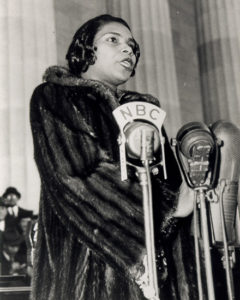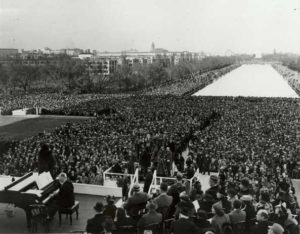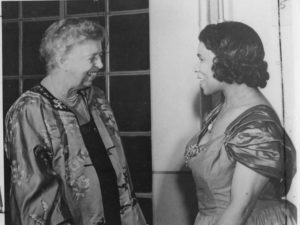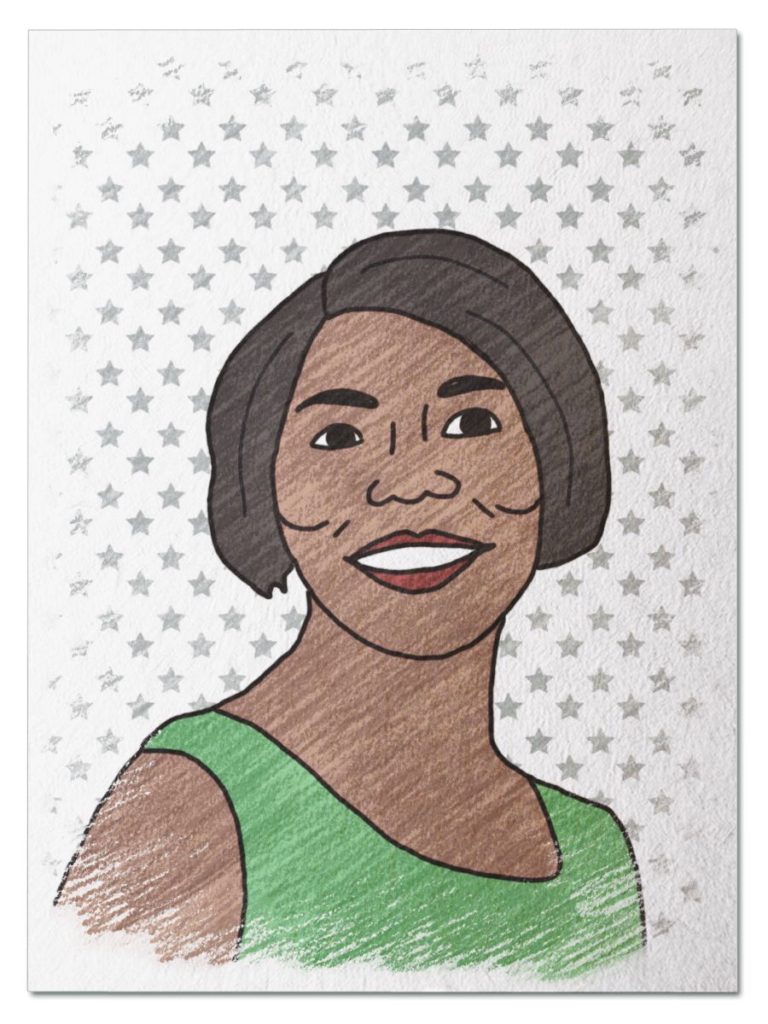
Exceptional Entertainer
When this internationally known opera star was barred from performing at Constitution Hall due to its “white performers only” policy, she sang in front of the Lincoln Memorial for thousands and broke racial barriers along the way. Transport yourself to Easter Sunday, 1939 and meet Marian Anderson…
Her Ruby Shoe Moment
The Power of the Wand
Her Yellow Brick Road
Brains, Heart & Courage
Glinda’s Gallery
Just the Facts
Her Ruby Shoe Moment
Marian Anderson looked out at the crowd on the National Mall. It was five o’clock in the evening on Easter Sunday, 1939. And there were over 75,000 people standing in the cold, from the Lincoln Memorial to the Washington Monument.
Secretary of the Interior Harold Ickes stepped up to the microphone to introduce Marian. Not that she needed an introduction — she was an internationally-known opera star. During his speech, Secretary Ickes said:
“In this great auditorium under the sky, all of us are free. Genius, like Justice, is blind. Genius draws no color lines.”
Marian was nervous. At age 42, she had already given hundreds of concerts. But she had never performed before such a large crowd. And she knew that millions of people across America would be listening on their radios at home. She also understood that this was more than a concert — she was making history.
Marian stood on the top steps of the Lincoln Memorial. Over 200 VIPs sat behind her, including her mom and sister, Supreme Court justices, senators, and Cabinet members. But the Roosevelts stayed away — Eleanor didn’t want to take the spotlight from Marian.
It was just Marian and her pianist on stage for the 25-minute concert. The first half was classical music, followed by an intermission and then gospel music. The sun came out as she sang her first song, My Country Tis of Thee. But she changed the words — “of thee WE sing” instead of “of thee I sing” (listen to the recording!). Marian went on to sing Ave Maria and some of her favorite gospel hymns.
As she sang her last note, Marian looked out at the sea of people. The entire crowd was completely silent, then broke into thunderous applause. They didn’t stop until she came back for one more song. Marian sang the spiritual hymn, Nobody Knows the Trouble I’ve Seen, as an encore.
People rushed the stage and Marian had to be escorted out by police. After the concert, Marian was exhausted. And she was done breaking barriers for the day. So she went back to her usual practice of staying with a friend for the night, since she didn’t know if any hotel in DC would accept her.
After the concert, Secretary Ickes’ office was flooded with hundreds of letters from people around the country — they expressed their gratitude for the concert and supported Marian’s bravery.
The Power of the Wand
Marian’s Freedom Concert at the Lincoln Memorial brought national attention to the issue of racism in America. And she earned respect throughout the world for her dignity in the face of discrimination. Even though Marian never considered herself a civil rights advocate, her actions set the stage for the civil rights era. Marian also helped to break the color barrier for musicians and other performers. In fact, some people called her concert one of the most important musical events of the 20th century.
Marian inspired the next generation of civil rights leaders, including Rev. Martin Luther King, Jr. He was 10 years old when the Freedom Concert took place and it left a big impression. In fact, he highlighted the event during a speaking contest while he was a junior in high school (he won). And Marian returned to the Lincoln Memorial for his March on Washington in 1963 and performed after King’s famous “I Have a Dream” speech.
Marian’s legacy continues on today in girls across America — check out activist and author Marley Dias. When she was 11 years old, Marley was annoyed that very few main characters in children’s literature looked like her. So she started a campaign called #1000BlackGirlBooks — it highlights books with black girls as protagonists, collects and donates books, and promotes diversity.
Her Yellow Brick Road
Back in the 1930s, it was tough to be a black opera singer in America. Marian encountered racism everywhere she went. Most theaters were closed to her, so she performed at black churches and college auditoriums. She was denied hotel rooms, refused service at restaurants, pushed to the back of trains, and forced to enter side doors of buildings.
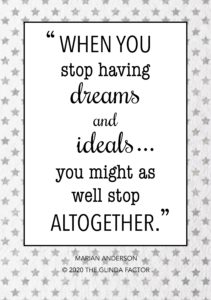 This pattern of racism is what caused the controversy leading up to Marian’s Freedom Concert. It all started when Marian agreed to sing as part of Howard University’s concert series. It was her third year and demand for tickets had grown larger and larger. By 1939, there wasn’t a venue on campus large enough to accommodate the anticipated crowds.
This pattern of racism is what caused the controversy leading up to Marian’s Freedom Concert. It all started when Marian agreed to sing as part of Howard University’s concert series. It was her third year and demand for tickets had grown larger and larger. By 1939, there wasn’t a venue on campus large enough to accommodate the anticipated crowds.
Howard University decided to book the largest concert hall in Washington DC — Constitution Hall. The Daughters of the American Revolution (DAR), which owned the building, replied immediately. The answer was “NO.” Constitution Hall was for white performers only. Despite her international fame, Marian was not welcome.
Now what? They had already announced the concert date. It was too late to back out. Even more, no one wanted to back out. It was time to take a stand.
Luckily, Marian had the support of the most powerful woman in America. First Lady Eleanor Roosevelt was appalled at Marian’s treatment in DC. She resigned from the DAR in protest — her resignation letter stated, “I am in complete disagreement with the attitude taken in refusing Constitution Hall to a great artist.” Then, she wrote about the situation in her weekly column, which was published in newspapers across the country. And privately she supported the idea that Marian should sing on the National Mall.
Everyone in Marian’s team loved the idea of an “open air” concert. They worked with officials at the Department of the Interior, which managed all federal land (including the National Mall). Secretary Ickes also liked the idea, but wanted to run it by the president. FDR enthusiastically approved and it was official.
Marian Anderson would perform a free concert on the steps of the Lincoln Memorial on Easter Sunday. Anyone was welcome to attend, black or white, rich or poor.
Brains, Heart & Courage
 Marian showed musical talent as early as four years old. Her family’s church was her main source of support — she joined the junior choir of her church at just six years old, then the senior choir when she was age 13. Everyone who heard her sing at the Union Baptist Church were impressed with her talent, and she received many offers to perform as a result.
Marian showed musical talent as early as four years old. Her family’s church was her main source of support — she joined the junior choir of her church at just six years old, then the senior choir when she was age 13. Everyone who heard her sing at the Union Baptist Church were impressed with her talent, and she received many offers to perform as a result.
Marian didn’t receive any formal training while she was young because her family couldn’t afford lessons. Then, when she was a teenager, her church raised about $600 for her to study music. She applied to a music school in Philadelphia, but was denied entry because of her race. So she began to train privately with a number of vocal teachers.
Marian’s big break came when she was 28 years old. She won first place in the National Music League competition — the judges’ decision was unanimous! Unfortunately, the victory didn’t help her career. It was clear that Marian’s opportunities were limited in America, simply due to the color of her skin.
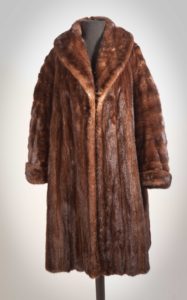
The mink coat that Marian wore for the Freedom Concert, Anacostia Community Museum, Smithsonian Institution
So Marian decided to try Europe. And she was pleasantly surprised. She was welcomed with open arms in most countries. She finally found the support and education she needed to grow as an artist. She trained with some of Europe’s best opera teachers, entered some prestigious music contests, and got a steady request for performances.
Before long, Marian became an international sensation. Her concerts sold out everywhere. She even performed for royalty such as King Gustav of Sweden. And she was treated like royalty herself in most cities, staying in the best hotels and dining at the finest restaurants. It was a stark contrast to how she was treated back home, especially in the South.
Marian’s experiences in Europe gave her the courage and confidence to come back to America and, in her quiet and dignified way, push for change.
Glinda’s Gallery
Visit Marian’s digital scrapbook on Pinterest: https://www.pinterest.com/theglindafactor/marian-anderson/
Just the Facts
- Marian was born on February 27, 1897 in Philadelphia. She was the oldest of three daughters and grew up in a working class neighborhood of Philadelphia. Her father died when she was 12 and the family moved to her grandmother’s house.
- In 1936, Marian became the first African American to perform at the White House. She also performed at the presidential inaugurations of both Dwight Eisenhower and John F. Kennedy.
- Marian kept a rigorous concert schedule — she performed between 70-100 concerts per year. In 1938, she traveled over 25,000 miles and performed about 90 concerts in 7 months (it was one of the longest tours given by a singer in American history). During her 60-year career, she performed over 1,000 concerts all over the world.
- In 1943, artist Mitchell Jamieson painted a mural of Marian’s famous Freedom Concert in the Department of the Interior’s headquarters. It is still there today.
- In 1943, Marian married Orpheus Fisher. They had no children.
- Marian underwent a surgery in 1948 to remove a growth in her throat. There was a chance she wouldn’t sing again, but her voice remained the same after recovery.
- Marian retired in 1965 and lived on her farm in Connecticut. Her Philadelphia home is now a museum and her papers are archived at Smith College in Massachusetts. She moved to Portland to live with her nephew in 1992 and died on April 8, 1993 at 96 years old.
- Marian won many awards during her lifetime, as well as honorary degrees from six universities. Here are just a few:
1939 – NAACP Springarn Medal
1963 – Presidential Medal of Freedom
1972 – United Nations Peace Prize
1977 – Congressional Gold Medal
1978 – Kennedy Center Honors
1986 – National Medal of Arts
1991 – Grammy Award for Lifetime Achievement
Want to Know More?
Arsenault, Raymond. The Sound of Freedom: Marian Anderson, the Lincoln Memorial, and the Concert that Awakened America (New York: Bloomsbury Press, 2009).
Anderson, Marian. My Lord, What a Morning. (Champaign: University of Illinois Press, 1956).
Freedman, Russell. The Voice that Challenged the Nation: Marian Anderson and the Struggle for Equal Rights. (New York: Clarion Books, 2004).

